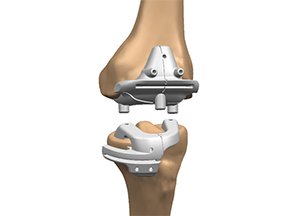
Knee replacement surgery is one of the great success stories in medical history. Now it has an even rosier future.
Knee surgery has been a huge success story, with the number of procedures in this country somewhere over 600,000 a year and growing. Up to 95% of patients report a good outcome ten years after surgery (according to U.S. Health & Human Services).
One minor flaw in this golden tale has been fit. Anyone can see that knees come in a variety of shapes and sizes. Till now, the surgeon has been charged with taking a standard implant and then adjusting the terrain during the operation so that the implant fits comfortably. Now there is a new technique for this adjustment process.
 A product called Visionaire Patient Match takes your x-rays and MRI images and custom-designs a knee implant before the surgery. The result is less time on the operating table, better-fitting artificial joints, and less wear-and-tear from dislocation and tissue degeneration.
A product called Visionaire Patient Match takes your x-rays and MRI images and custom-designs a knee implant before the surgery. The result is less time on the operating table, better-fitting artificial joints, and less wear-and-tear from dislocation and tissue degeneration.
It’s a little like having a dental device that’s made to fit your mouth instead of an off-the-shelf, store-bought set of choppers.
Visionaire Equals Visionary
The wonder is that it tooks this long for someone to come up with a custom-fit knee replacement. Smith & Nephew, a medical device company that’s been in business for 150 years, maintains that their implant is designed to eliminate some major concerns with knee surgery, including:
- Reducing surgical time
- Minimizing bone removal
- Shrinking of the variance in joint alignment (to just tenths of a millimeter)
- Promoting faster recovery
- Extending the life of the joint
Who Is a Candidate for Visionaire Patient Match?
In the past, knee surgery was considered a last option— after conservative therapies had failed or a patient’s mobiity was hindered. It was not uncommon for doctors to advise patients in their 40s and 50s to wait as long as possible.
 Today we are seeing younger patients— in fact, patients of all ages— appear at the clinic. This is due to several factors.
Today we are seeing younger patients— in fact, patients of all ages— appear at the clinic. This is due to several factors.
One is that many Americans have embraced a vigorous lifestyle. They can’t imagine a week without a bicycle ride, golf, running, dancing or other regular exercise, sport or activity.
Another reason for the increasing popularity of total and partial knee replacement is an improvement in the technology.
We’ve come a long way since the 1860s, when a German doctor implanted a hinge made of ivory in a patient’s knee. By the 1970s, condylar total knee replacements came onboard; however, the device was available in only two sizes and was composed of a solid block. The Visionaire Patient Match is state-of-the-(medical) art.
What to Expect With a Custom Fit Knee Replacement
The indications for knee surgery remain the same. Nearly all of our surgical candidates have osteoarthritis resulting from age-related or traumatic damage to the various components (ligaments, cartilage, bone, membrane) of the knee.
Generally, we tell patients that they can expect the same from a custom knee as they would from the more traditional procedure— just a better outcome, and longer service.
The difference is in what we do before surgery, and how the knee responds after surgery. In anticipation of the procedure, we order x-rays and MRI and send the images to a laboratory where custom tools and instruments are designed and manufactured for your joint.
After surgery, the custom implant is expected to wear more smoothly because of more precise alignment. It is common to see less dislocation and wear-and-tear— as well as pain and swelling— than we would with a conventional device.
Not everybody is a candidate for knee replacement. Each patient must be evaluated individually. But doesn’t it make sense that a patient’s treatment— i.e., surgery— should also be designed individually? Makes sense to us.











